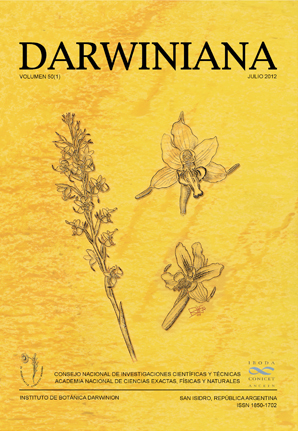Zoosporic true fungi, heterotrophic straminipiles and plasmodiophorids: status of knowledge in South America
DOI:
https://doi.org/10.14522/darwiniana.2014.501.482Keywords:
Argentina, Brazil, heterotrophic straminipiles, plasmodiophorids, zoosporic true fungiAbstract
Zoosporic true fungi and fungal-like organisms include unrelated groups in the kingdoms Fungi, Straminipila and Protozoa. There is very little information on the diversity of these organisms in many ecosystems of great biodiversity, particularly tropical or neotropicalareas. Research assessing their diversity has been mainly conducted in Argentina and Brazil using multiple baiting techniques, resulting in the discovery of many new taxa and new records. To date, 434 species in these groups have been recorded for both countries. Continuing research is necessary to provide a more comprehensive understanding of their diversity in South America. Few specialists are available to study such extensive areas, which are being degraded by deforestation, land/clearing, pollution and other anthropogenic activities that affect the habitat of these organisms, long before surveys can be carried out by mycologists and protistologists. Hence, attempts to gather information about the diversity of zoosporic organisms from South America are urgently needed, and should receive high priority.Downloads
Published
31-07-2012
How to Cite
Steciow, M. M., Milanez, A. I., Pires-Zottarelli, C. L. A., Marano, A. V., Letcher, P. M., & Vélez, C. G. (2012). Zoosporic true fungi, heterotrophic straminipiles and plasmodiophorids: status of knowledge in South America. Darwiniana, Nueva Serie, 50(1), 25–32. https://doi.org/10.14522/darwiniana.2014.501.482
Issue
Section
Systematics and Taxonomy of Algae and Fungi
License

Starting on 2012, Darwiniana Nueva Serie uses Licencia Creative Commons Atribución-NoComercial 2.5 Argentina .






